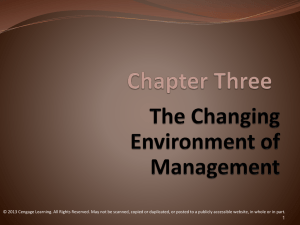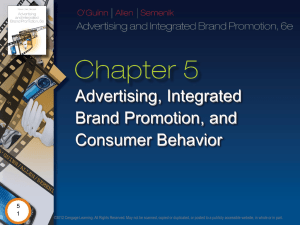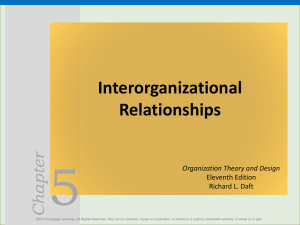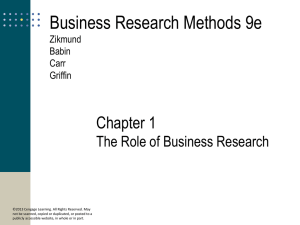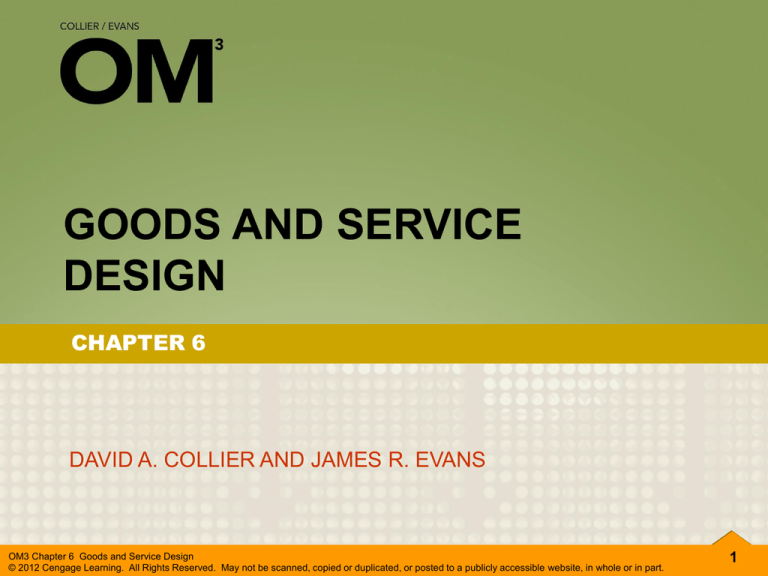
GOODS AND SERVICE
DESIGN
CHAPTER 6
DAVID A. COLLIER AND JAMES R. EVANS
OM3 Chapter 6 Goods and Service Design
© 2012 Cengage Learning. All Rights Reserved. May not be scanned, copied or duplicated, or posted to a publicly accessible website, in whole or in part.
1
CHAPTER 6
GOODS AND SERVICE DESIGN
LO1
Describe the steps involved in designing goods and
services.
LO2
Explain the concept and application of Quality Function
Deployment.
LO3
Describe how the Taguchi loss function, reliability,
design for manufacturability, and design for
sustainability are used for designing manufactured
goods.
LO4
Explain the five elements of service delivery system
design.
LO5
LO6
Describe the four elements of service encounter design.
Explain how goods and service design concepts are
integrated at LensCrafters.
OM3 Chapter 6 Goods and Service Design
© 2012 Cengage Learning. All Rights Reserved. May not be scanned, copied or duplicated, or posted to a publicly accessible website, in whole or in part.
2
i
CHAPTER 6
GOODS AND SERVICE DESIGN
n developing markets such as China and India, consumers can’t afford
large, expensive cars, much less drive them in overcrowded population
centers. Fuel efficiency as well as environmental concerns are also
important, as developing nations seek to cap carbon emissions even as
the number of vehicles on their streets continues to rise. But these
consumers are not willing to buy inferior cars that simply cost less.
Rather, like most of us, they want low-cost vehicles that are designed to
meet their needs and still have high quality, reliability, and style—in
other words, have value. Consumers in India, for instance, need cars
that maximize passenger room because they use their autos primarily
as family vehicles to drive around town; by contrast, in the West, with
its better roads and routine long-distance driving, cargo capacity
matters more.
OM3 Chapter 6 Goods and Service Design
© 2012 Cengage Learning. All Rights Reserved. May not be scanned, copied or duplicated, or posted to a publicly accessible website, in whole or in part.
3
CHAPTER 6
GOODS AND SERVICE DESIGN
Indian drivers are willing to pay a bit more for cars that
offer the latest in comfort, safety, and utility, but not for
cars with power windows and locks or fancy sound
systems. Automatic transmissions are desirable in India
and China—nobody wants to keep pressing the clutch and
shifting gears in the inevitable stop-and-go traffic—but
powerful engines are not. Succeeding in developing
markets, therefore, requires rethinking from start to finish
how new cars should be designed and built. It calls for a
deep understanding of the unique needs of consumers and
the ability to assemble the combination of power trains,
bodies, features, and options that best match those
desires—at affordable prices.
OM3 Chapter 6 Goods and Service Design
© 2012 Cengage Learning. All Rights Reserved. May not be scanned, copied or duplicated, or posted to a publicly accessible website, in whole or in part.
4
CHAPTER 6
GOODS AND SERVICE DESIGN
What do you think?
How important are
design and style in
your purchasing
decisions? Provide
examples for goods
and services.
OM3 Chapter 6 Goods and Service Design
© 2012 Cengage Learning. All Rights Reserved. May not be scanned, copied or duplicated, or posted to a publicly accessible website, in whole or in part.
5
CHAPTER 6
GOODS AND SERVICE DESIGN
Every design project—a new automobile or
cell phone, a new online or financial service,
and even a new pizza—is a series of tradeoffs: between technology and functionality,
between ambition and affordability,
between the desires of the people creating
the object and the needs of the people
using it.
OM3 Chapter 6 Goods and Service Design
© 2012 Cengage Learning. All Rights Reserved. May not be scanned, copied or duplicated, or posted to a publicly accessible website, in whole or in part.
6
CHAPTER 6
GOODS AND SERVICE DESIGN
Exhibit 6.1 An Integrated Framework for Goods and Service Design (slide 1)
OM3 Chapter 6 Goods and Service Design
© 2012 Cengage Learning. All Rights Reserved. May not be scanned, copied or duplicated, or posted to a publicly accessible website, in whole or in part.
7
CHAPTER 6
GOODS AND SERVICE DESIGN
Exhibit 6.1 An Integrated Framework for Goods and Service Design (slide 2)
OM3 Chapter 6 Goods and Service Design
© 2012 Cengage Learning. All Rights Reserved. May not be scanned, copied or duplicated, or posted to a publicly accessible website, in whole or in part.
8
CHAPTER 6
GOODS AND SERVICE DESIGN
Designing Goods and Services
CBP design and configuration choices revolve around a
solid understanding of customer needs and target markets,
and the value that customers place on attributes, such as:
•
•
•
•
•
•
Time: Reduce waiting time, be more responsive to
customer needs.
Place: Select location for customer convenience.
Information: Provide product support, user manuals.
Entertainment: Enhance customer experience.
Exchange: Multiple channels used for purchases.
Form: How well the physical characteristics of a good
address customer needs.
OM3 Chapter 6 Goods and Service Design
© 2012 Cengage Learning. All Rights Reserved. May not be scanned, copied or duplicated, or posted to a publicly accessible website, in whole or in part.
9
CHAPTER 6
GOODS AND SERVICE DESIGN
Designing Goods and Services
The design of a manufactured good focuses on its
physical characteristics—dimensions, materials,
color, and so on.
The design of a service, however, cannot be done
independently from the “process” by which the
service is delivered. The process by which the
service is created and delivered (that is,
“produced”) is, in essence, the service itself!
OM3 Chapter 6 Goods and Service Design
© 2012 Cengage Learning. All Rights Reserved. May not be scanned, copied or duplicated, or posted to a publicly accessible website, in whole or in part.
10
CHAPTER 6
GOODS AND SERVICE DESIGN
Designing Goods and Services
• Prototype testing is the process by which a
model (real or simulated) is constructed to test
the good’s physical properties or use under
actual operating conditions, as well as consumer
reactions to the prototype.
OM3 Chapter 6 Goods and Service Design
© 2012 Cengage Learning. All Rights Reserved. May not be scanned, copied or duplicated, or posted to a publicly accessible website, in whole or in part.
11
CHAPTER 6
GOODS AND SERVICE DESIGN
Customer-Focused Design
• Customer requirements, as expressed in the
customer’s own terms, are called the voice of the
customer.
• Quality function deployment (QFD) is an
approach to guide the design, creation, and
marketing of goods and services by integrating the
voice of the customer into all decisions.
• QFD translates customer wants and needs into
technical requirements of a product or service.
OM3 Chapter 6 Goods and Service Design
© 2012 Cengage Learning. All Rights Reserved. May not be scanned, copied or duplicated, or posted to a publicly accessible website, in whole or in part.
12
CHAPTER 6
GOODS AND SERVICE DESIGN
The House of Quality
Building the House of Quality:
1. Determine customer requirements through the voice of
the customer (VOC).
2. Define technical requirements of the product.
3. Determine interrelationships between the technical
requirements.
4. The relationship matrix defines what technical
requirements satisfy VOC needs.
5. Customer priorities and competitive evaluation help
select which VOC requirements the product should focus
on.
OM3 Chapter 6 Goods and Service Design
© 2012 Cengage Learning. All Rights Reserved. May not be scanned, copied or duplicated, or posted to a publicly accessible website, in whole or in part.
13
CHAPTER 6
GOODS AND SERVICE DESIGN
Exhibit 6.2 The House of Quality
OM3 Chapter 6 Goods and Service Design
© 2012 Cengage Learning. All Rights Reserved. May not be scanned, copied or duplicated, or posted to a publicly accessible website, in whole or in part.
14
CHAPTER 6
GOODS AND SERVICE DESIGN
Exhibit Extra A House of
Quality for
Building a
Better Pizza
OM3 Chapter 6 Goods and Service Design
© 2012 Cengage Learning. All Rights Reserved. May not be scanned, copied or duplicated, or posted to a publicly accessible website, in whole or in part.
15
CHAPTER 6
GOODS AND SERVICE DESIGN
Tolerance Design and the Taguchi Loss Function
• For most manufactured goods, design
blueprints specify a target dimension (called
the nominal), along with a range of permissible
variation (called the tolerance). For example,
0.500 0.020 cm.
• The nominal dimension is 0.500 cm, but may
vary anywhere in the range from 0.480 to
0.520 cm.
• This is sometimes called the “goal post
model.”
OM3 Chapter 6 Goods and Service Design
© 2012 Cengage Learning. All Rights Reserved. May not be scanned, copied or duplicated, or posted to a publicly accessible website, in whole or in part.
16
CHAPTER 6
GOODS AND SERVICE DESIGN
Exhibit 6.3 Traditional Goal Post View of Conforming to Specifications
OM3 Chapter 6 Goods and Service Design
© 2012 Cengage Learning. All Rights Reserved. May not be scanned, copied or duplicated, or posted to a publicly accessible website, in whole or in part.
17
CHAPTER 6
GOODS AND SERVICE DESIGN
Tolerance Design and the Taguchi Loss Function
Genichi Taguchi, a Japanese engineer,
maintained that the traditional practice of
setting design specifications is inherently
flawed. Taguchi argued that the smaller the
variation about the nominal specification, the
better is the quality. In turn, products are more
consistent, would fail less frequently, and thus,
be less costly in the long run.
OM3 Chapter 6 Goods and Service Design
© 2012 Cengage Learning. All Rights Reserved. May not be scanned, copied or duplicated, or posted to a publicly accessible website, in whole or in part.
18
CHAPTER 6
GOODS AND SERVICE DESIGN
Tolerance Design and the Taguchi Loss Function
Taguchi loss function:
L(x) = k(x – T )2
[6.1]
Where:
L(x) is the monetary value of the loss associated
with deviating from the target, T;
x is the actual value of the dimension;
k is a constant that translates the deviation into
dollars.
OM3 Chapter 6 Goods and Service Design
© 2012 Cengage Learning. All Rights Reserved. May not be scanned, copied or duplicated, or posted to a publicly accessible website, in whole or in part.
19
CHAPTER 6
GOODS AND SERVICE DESIGN
Exhibit 6.4 Nominal-Is-Best Taguchi Loss Function
OM3 Chapter 6 Goods and Service Design
© 2012 Cengage Learning. All Rights Reserved. May not be scanned, copied or duplicated, or posted to a publicly accessible website, in whole or in part.
20
CHAPTER 6
GOODS AND SERVICE DESIGN
OM3 Chapter 6 Goods and Service Design
© 2012 Cengage Learning. All Rights Reserved. May not be scanned, copied or duplicated, or posted to a publicly accessible website, in whole or in part.
21
CHAPTER 6
GOODS AND SERVICE DESIGN
Solved Problem
Suppose that the specification on a part is 0.500 ± 0.020 cm. A detailed
analysis of product returns and repairs has discovered that many failures
occur when the actual dimension is near the extreme of the tolerance
range (that is, when the dimensions are approximately 0.48 or 0.52) and
costs $50 for repair.
Thus, in Equation 6.1, the deviation from the target, x – T , is 0.02 and
L(x) = $50. Substituting these values, we have:
50 = k(0.02)2
or
k = 50/0.0004 = 125,000
Therefore, the loss function for a single part is L(x) = 125000(x – T)2.
This means when the deviation is 0.10, the firm can still expect a loss per
unit of: L(0.51) = 125,000(0.10)2 = $12.50 per part
OM3 Chapter 6 Goods and Service Design
© 2012 Cengage Learning. All Rights Reserved. May not be scanned, copied or duplicated, or posted to a publicly accessible website, in whole or in part.
22
CHAPTER 6
GOODS AND SERVICE DESIGN
Design for Reliability
• Reliability is the probability that a
manufactured good, piece of equipment, or
system performs its intended function for a
stated period of time under specified operating
conditions.
OM3 Chapter 6 Goods and Service Design
© 2012 Cengage Learning. All Rights Reserved. May not be scanned, copied or duplicated, or posted to a publicly accessible website, in whole or in part.
23
CHAPTER 6
GOODS AND SERVICE DESIGN
Design for Reliability
• Reliability is a probability, that is, a value
between 0 and 1.
Example: A reliability of 0.97 means that on
average, 97 of 100 times the item will perform
its function for a given period of time under
specified operating conditions.
• Many designs have components arranged in
series; others consist of parallel components
that function independently of each other.
OM3 Chapter 6 Goods and Service Design
© 2012 Cengage Learning. All Rights Reserved. May not be scanned, copied or duplicated, or posted to a publicly accessible website, in whole or in part.
24
CHAPTER 6
GOODS AND SERVICE DESIGN
Design for Reliability
In a series system, if one component fails, the entire
system fails. The reliability of a series system is the
product of the individual probabilities of each process in
a system.
Rs = (p1)(p2)(p3). . . (pn)
[6.2]
Exhibit 6.5 Structure of a Serial System
OM3 Chapter 6 Goods and Service Design
© 2012 Cengage Learning. All Rights Reserved. May not be scanned, copied or duplicated, or posted to a publicly accessible website, in whole or in part.
25
CHAPTER 6
Design for Reliability
GOODS AND SERVICE DESIGN
Exhibit 6.6 Structure of a Parallel System
In parallel systems,
functions are
independent and the
entire system will fail
only if all components
fail. The reliability of a
parallel system is
computed as:
Rp = 1 – (1 – p1)(1 – p2)(1 – p3). . . (1 – pn)
[6.3]
OM3 Chapter 6 Goods and Service Design
© 2012 Cengage Learning. All Rights Reserved. May not be scanned, copied or duplicated, or posted to a publicly accessible website, in whole or in part.
26
CHAPTER 6
GOODS AND SERVICE DESIGN
Design for Reliability
Example: The reliability of this series system is:
Rs = (.98)(.91)(.99) = .883 or 88.3%
Exhibit 6.7 Subassembly Reliabilities
OM3 Chapter 6 Goods and Service Design
© 2012 Cengage Learning. All Rights Reserved. May not be scanned, copied or duplicated, or posted to a publicly accessible website, in whole or in part.
27
CHAPTER 6
GOODS AND SERVICE DESIGN
Design for Reliability
Series-Parallel Systems: The reliability of the parallel system for
subassembly B is: Rp = 1 – (1 – .91)(1 – .91) = 1 – 0.0081 =
0.9919.
Exhibit 6.8 Modified Design
Thus, the reliability of the
entire system is:
Rs = (.98)(.9919)(.99) =
.962 or 96.2%.
OM3 Chapter 6 Goods and Service Design
© 2012 Cengage Learning. All Rights Reserved. May not be scanned, copied or duplicated, or posted to a publicly accessible website, in whole or in part.
28
CHAPTER 6
GOODS AND SERVICE DESIGN
Design for Reliability
• Design failure-mode-and-effects analysis
(DFMEA) is a technique for identifying how a
product may fail; the effect of a failure on the
customer; seriousness, likelihood of occurrence,
and ability to detect a potential failure; cause of
failure, and how it can be corrected by
improving the design.
OM3 Chapter 6 Goods and Service Design
© 2012 Cengage Learning. All Rights Reserved. May not be scanned, copied or duplicated, or posted to a publicly accessible website, in whole or in part.
29
CHAPTER 6
GOODS AND SERVICE DESIGN
Design for Manufacturability
• Design for manufacturability (DFM) is the
process of designing a product for efficient
production at the highest level of quality.
• Product simplification is the process of trying
to simplify designs to reduce complexity and
costs and thus improve productivity, quality,
flexibility, and customer satisfaction.
OM3 Chapter 6 Goods and Service Design
© 2012 Cengage Learning. All Rights Reserved. May not be scanned, copied or duplicated, or posted to a publicly accessible website, in whole or in part.
30
CHAPTER 6
GOODS AND SERVICE DESIGN
Design for Sustainability
• Many products are discarded simply because the
cost of maintenance or repair is too high when
compared with the cost of a new item. One aspect
of designing for sustainability is designing products
that can easily be repaired and refurbished or
otherwise salvaged for reuse.
• Design for Environment (DfE) is the explicit
consideration of environmental concerns during the
design of goods, services, and processes and
includes such practices as designing for recycling
and disassembly.
OM3 Chapter 6 Goods and Service Design
© 2012 Cengage Learning. All Rights Reserved. May not be scanned, copied or duplicated, or posted to a publicly accessible website, in whole or in part.
31
CHAPTER 6
GOODS AND SERVICE DESIGN
OM3 Chapter 6 Goods and Service Design
© 2012 Cengage Learning. All Rights Reserved. May not be scanned, copied or duplicated, or posted to a publicly accessible website, in whole or in part.
32
CHAPTER 6
GOODS AND SERVICE DESIGN
Service Delivery System Design
Service delivery system design includes the
following:
• Facility location and layout
• The servicescape
• Process and job design
• Technology and information support systems
• Organizational structure
OM3 Chapter 6 Goods and Service Design
© 2012 Cengage Learning. All Rights Reserved. May not be scanned, copied or duplicated, or posted to a publicly accessible website, in whole or in part.
33
CHAPTER 6
GOODS AND SERVICE DESIGN
Service Delivery System Design
Facility Location and Layout
• Location creates customer’s convenience.
• Great store layout, process design, and service
encounter design are meaningless if the store is
in the wrong location.
• The Internet is making physical locations less
important for some information-intensive
services such as Charles Schwab, Vanguard,
and Scottrade.
OM3 Chapter 6 Goods and Service Design
© 2012 Cengage Learning. All Rights Reserved. May not be scanned, copied or duplicated, or posted to a publicly accessible website, in whole or in part.
34
CHAPTER 6
GOODS AND SERVICE DESIGN
Service Delivery and System Design
Servicescape
• All of the physical evidence a customer might
use to form an impression.
• The servicescape provides the behavioral setting
where service encounters take place.
• Standardization of the servicescape and service
processes enhances efficiency, especially for
multiple site organizations.
OM3 Chapter 6 Goods and Service Design
© 2012 Cengage Learning. All Rights Reserved. May not be scanned, copied or duplicated, or posted to a publicly accessible website, in whole or in part.
35
CHAPTER 6
GOODS AND SERVICE DESIGN
Three Dimensions of a Servicescape
• Ambient conditions—manifest by sight, sound,
smell, touch, and temperature; five human senses;
e.g., leather chairs in the lobby, cartoon characters in
children’s hospital, music at a coffee shop.
• Spatial layout and functionality—how furniture,
equipment, and office spaces are arranged; also
streets, parking lots, stadiums, etc.
• Signs, symbols, and artifacts—explicit signals that
communicate an image of the firm; e.g., diplomas
hanging on the wall in a medical clinic, company
logos and uniforms, artwork, mission statements.
OM3 Chapter 6 Goods and Service Design
© 2012 Cengage Learning. All Rights Reserved. May not be scanned, copied or duplicated, or posted to a publicly accessible website, in whole or in part.
36
CHAPTER 6
GOODS AND SERVICE DESIGN
Types of Servicescapes
• Some servicescapes, termed lean servicescape
environments, are very simple.
Examples: Ticketron outlets, FedEx drop-off
kiosks
• More complicated designs and service systems
are termed elaborate servicescape
environments.
Examples: Hospitals, airports, universities
OM3 Chapter 6 Goods and Service Design
© 2012 Cengage Learning. All Rights Reserved. May not be scanned, copied or duplicated, or posted to a publicly accessible website, in whole or in part.
37
CHAPTER 6
GOODS AND SERVICE DESIGN
Service Process and Job Design
Service process design is the activity of
developing an efficient sequence of activities to
satisfy internal and external customer requirements.
Develop procedures to ensure that:
• Things are done right the first time.
• Interactions between customers and service
providers are simple and quick.
• Human error is avoided.
OM3 Chapter 6 Goods and Service Design
© 2012 Cengage Learning. All Rights Reserved. May not be scanned, copied or duplicated, or posted to a publicly accessible website, in whole or in part.
38
CHAPTER 6
GOODS AND SERVICE DESIGN
Service Process and Job Design
Technology and Information Support Systems
• What technology does each job require?
• What information technology best integrates all
parts of the value chain?
• Technology ensures speed, accuracy,
customization, and flexibility.
OM3 Chapter 6 Goods and Service Design
© 2012 Cengage Learning. All Rights Reserved. May not be scanned, copied or duplicated, or posted to a publicly accessible website, in whole or in part.
39
CHAPTER 6
GOODS AND SERVICE DESIGN
Service Process and Job Design
Organizational Structure
• Pure functional organization requires more
handoffs between work activities and results in
increased opportunity for error and slower
processing times.
• Process-based organization leverages crossfunctionality of service processes.
OM3 Chapter 6 Goods and Service Design
© 2012 Cengage Learning. All Rights Reserved. May not be scanned, copied or duplicated, or posted to a publicly accessible website, in whole or in part.
40
CHAPTER 6
GOODS AND SERVICE DESIGN
Service Encounter Design
Service encounter design focuses on the
interaction, directly or indirectly, between the
service provider(s) and the customer.
Principal elements:
• Customer contact behavior and skills
• Service provider selection, development, and
empowerment
• Recognition and reward
• Service recovery and guarantees
OM3 Chapter 6 Goods and Service Design
© 2012 Cengage Learning. All Rights Reserved. May not be scanned, copied or duplicated, or posted to a publicly accessible website, in whole or in part.
41
CHAPTER 6
GOODS AND SERVICE DESIGN
Service Encounter Design
Customer Contact Behavior and Skills
• Customer contact refers to the physical or virtual
presence of the customer in the service delivery
system during a service experience.
• Customer contact is measured by the percentage of
time the customer must be in the system relative to
the total time it takes to provide the service.
• Systems in which the percentage is high are called
high-contact systems; those in which it is low are
called low-contact systems.
OM3 Chapter 6 Goods and Service Design
© 2012 Cengage Learning. All Rights Reserved. May not be scanned, copied or duplicated, or posted to a publicly accessible website, in whole or in part.
42
CHAPTER 6
GOODS AND SERVICE DESIGN
Service Encounter Design
• Customer-contact requirements are
measurable performance levels or expectations
that define the quality of customer contact with
representatives of an organization.
• Examples:
– Answering a telephone within two rings
– Using a customer’s name whenever possible
OM3 Chapter 6 Goods and Service Design
© 2012 Cengage Learning. All Rights Reserved. May not be scanned, copied or duplicated, or posted to a publicly accessible website, in whole or in part.
43
CHAPTER 6
GOODS AND SERVICE DESIGN
Service Encounter Design
Service Provider Selection, Development and
Empowerment
•
•
Recruit and train employees to exceed customer
expectations.
Empowerment simply means giving people authority to
make decisions based on what they feel is right, to have
control over their work, to take risks and learn from
mistakes, and to promote change.
– Ritz-Carlton Hotel employees can spend up to $2,000
to resolve customer complaints with no questions
asked.
OM3 Chapter 6 Goods and Service Design
© 2012 Cengage Learning. All Rights Reserved. May not be scanned, copied or duplicated, or posted to a publicly accessible website, in whole or in part.
44
CHAPTER 6
GOODS AND SERVICE DESIGN
Service Encounter Design
Recognition and Reward
• Key motivational factors:
Recognition
Advancement
Achievement
Nature of the work
OM3 Chapter 6 Goods and Service Design
© 2012 Cengage Learning. All Rights Reserved. May not be scanned, copied or duplicated, or posted to a publicly accessible website, in whole or in part.
45
CHAPTER 6
GOODS AND SERVICE DESIGN
Service Encounter Design
Service Guarantees and Recovery
• A service upset is any problem a customer
has—real or perceived—with the service
delivery system and includes terms such as
service failure, error, defect, mistake, or crisis.
• A service guarantee is a promise to reward
and compensate a customer if a service upset
occurs during the service experience.
OM3 Chapter 6 Goods and Service Design
© 2012 Cengage Learning. All Rights Reserved. May not be scanned, copied or duplicated, or posted to a publicly accessible website, in whole or in part.
46
CHAPTER 6
GOODS AND SERVICE DESIGN
Service Encounter Design
Service Guarantees and Recovery
• Service recovery is the process of correcting
a service upset and satisfying the customer.
Begin immediately after a service upset.
Document the process and train employees.
Listen to the customer and respond.
sympathetically.
Resolve the problem quickly, provide an apology,
offer compensation.
OM3 Chapter 6 Goods and Service Design
© 2012 Cengage Learning. All Rights Reserved. May not be scanned, copied or duplicated, or posted to a publicly accessible website, in whole or in part.
47
CHAPTER 6
GOODS AND SERVICE DESIGN
OM3 Chapter 6 Goods and Service Design
© 2012 Cengage Learning. All Rights Reserved. May not be scanned, copied or duplicated, or posted to a publicly accessible website, in whole or in part.
48
CHAPTER 6
GOODS AND SERVICE DESIGN
An Integrative Case Study of LensCrafters
• LensCrafters’ (www.lenscrafters.com) mission
statement suggests that time and service quality
are the most important competitive priorities and
potential order winners.
• CBP is the integrated set of goods (eyewear)
and services (accurate eye exam and one-hour
service).
OM3 Chapter 6 Goods and Service Design
© 2012 Cengage Learning. All Rights Reserved. May not be scanned, copied or duplicated, or posted to a publicly accessible website, in whole or in part.
49
CHAPTER 6
GOODS AND SERVICE DESIGN
An Integrative Case Study of LensCrafters
• Eyewear is produced in “store backroom factory”
in rapid response without sacrificing quality,
efficient production procedures.
• Service delivery system design:
Located in high-traffic areas for convenience.
Servicescape of quality and professionalism.
11 different in-store job roles.
Customers can see glasses being made in the
optical lab.
OM3 Chapter 6 Goods and Service Design
© 2012 Cengage Learning. All Rights Reserved. May not be scanned, copied or duplicated, or posted to a publicly accessible website, in whole or in part.
50
CHAPTER 6
GOODS AND SERVICE DESIGN
Exhibit 6.9 One Example View of LensCrafters’ Customer Benefit Package
OM3 Chapter 6 Goods and Service Design
© 2012 Cengage Learning. All Rights Reserved. May not be scanned, copied or duplicated, or posted to a publicly accessible website, in whole or in part.
51
CHAPTER 6
GOODS AND SERVICE DESIGN
Exhibit 6.10
A Schematic View of a
Typical LensCrafters
Store Layout
OM3 Chapter 6 Goods and Service Design
© 2012 Cengage Learning. All Rights Reserved. May not be scanned, copied or duplicated, or posted to a publicly accessible website, in whole or in part.
52
CHAPTER 6
GOODS AND SERVICE DESIGN
Gulf Coast Bank Case Study
1. What are the objectives of the service guarantee
program?
2. Is a total payout of $860 over 10 months for 300
branches good or bad?
3. Are the bank’s services and their processes truly
redesigned to meet the service guarantee promises?
4. Is GCB’s service guarantee program well-designed
and executed?
5. What are your final recommendations over the short
and long term?
OM3 Chapter 6 Goods and Service Design
© 2012 Cengage Learning. All Rights Reserved. May not be scanned, copied or duplicated, or posted to a publicly accessible website, in whole or in part.
53



